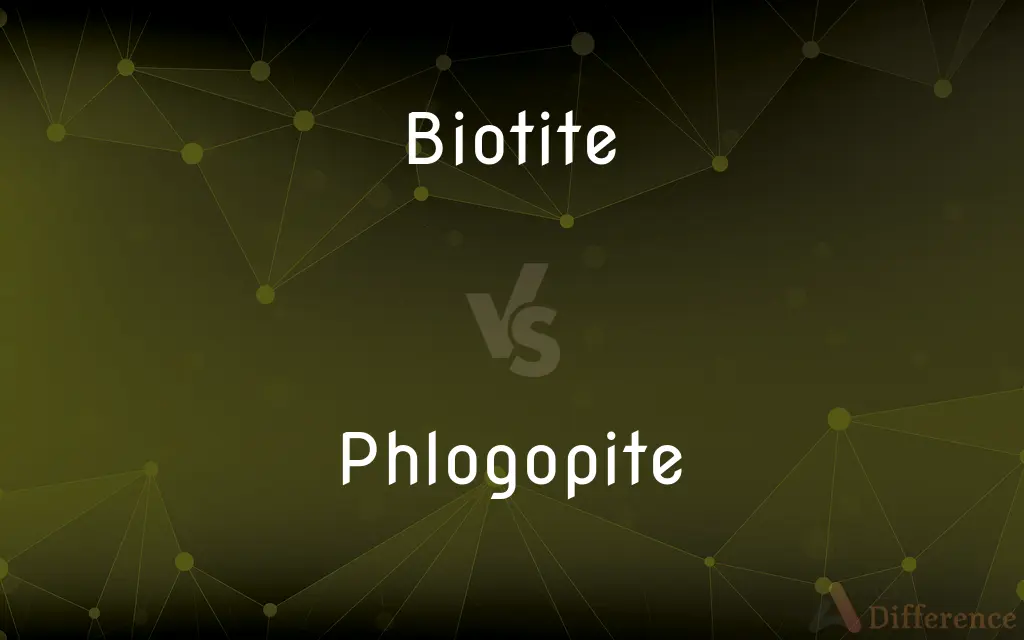Biotite vs. Phlogopite — What's the Difference?
By Urooj Arif & Maham Liaqat — Updated on April 16, 2024
Biotite is a dark, iron-rich mica, typically black or brown, known for its iron and magnesium content, while phlogopite, lighter in color, is magnesium-rich and often appears in shades of yellow, brown, or green.

Difference Between Biotite and Phlogopite
Table of Contents
ADVERTISEMENT
Key Differences
Biotite is generally darker due to its higher iron content, which influences its black to dark brown hues and makes it common in granitic rocks. Phlogopite, on the other hand, tends to be lighter, ranging from yellow to green, primarily due to its higher magnesium content, and is often found in metamorphic rocks.
Chemically, biotite includes more iron and aluminum in its composition, contributing to its typical physical properties such as greater density and hardness. Phlogopite, meanwhile, contains higher amounts of magnesium, which affects its chemical stability and thermal resistance.
In terms of crystal structure, both minerals are part of the mica group with layered silicate structures, but biotite's higher iron content typically results in a less flexible and darker sheet. Phlogopite sheets are usually more flexible and can withstand higher temperatures, making them valuable in industrial applications like insulators.
Optically, biotite is usually opaque in thin sections under a microscope, with a dark appearance. Phlogopite, however, tends to be translucent to transparent, offering clearer views of its internal crystal structure.
Biotite's prevalence in igneous environments, especially in granites and diorites, relates to its formation from magma. Phlogopite's association with metamorphic rocks like marble and ultramafic rocks points to its stability under different conditions of temperature and pressure.
ADVERTISEMENT
Comparison Chart
Color
Black, dark brown
Yellow, brown, green
Composition
Higher in iron and aluminum
Higher in magnesium
Crystal Structure
Less flexible, opaque
More flexible, translucent
Common Environments
Granitic and dioritic rocks
Metamorphic rocks
Thermal Stability
Lower thermal resistance
Higher thermal resistance
Compare with Definitions
Biotite
A dark mica mineral rich in iron and magnesium.
Biotite's black sheen is noticeable in granite countertops.
Phlogopite
A light-colored mica mineral predominantly containing magnesium.
Phlogopite's golden tint is often used in decorative stone applications.
Biotite
Is sensitive to weathering processes.
Biotite weathers to a rusty color when exposed to the elements.
Phlogopite
Typically found in metamorphic contexts.
Phlogopite layers are common in metamorphosed limestone.
Biotite
Commonly found in igneous rocks.
Biotite flakes are often visible in the coarse texture of granite.
Phlogopite
Often associated with ultramafic rocks.
Phlogopite is frequently discovered within the composition of ultramafic rock formations.
Biotite
Has significant opacity and density.
The density of biotite contributes to its use in geological studies.
Phlogopite
Shows higher translucency in thin sections.
Phlogopite's crystal structure is easily studied under a microscope due to its translucency.
Biotite
Used as a geothermobarometer in metamorphic studies.
Biotite's composition can indicate the temperature and pressure during rock formation.
Phlogopite
Known for its flexibility and heat resistance.
Phlogopite is used in industrial applications for its thermal insulation properties.
Biotite
Biotite is a common group of phyllosilicate minerals within the mica group, with the approximate chemical formula K(Mg,Fe)3AlSi3O10(F,OH)2. It is primarily a solid-solution series between the iron-endmember annite, and the magnesium-endmember phlogopite; more aluminous end-members include siderophyllite and eastonite.
Phlogopite
Phlogopite is a yellow, greenish, or reddish-brown member of the mica family of phyllosilicates. It is also known as magnesium mica.
Biotite
A dark-brown or dark-green to black mica, K(Mg,Fe)3(Al,Fe)Si3O10(OH)2, found in igneous and metamorphic rocks.
Phlogopite
A yellow to dark brown mica, K(Mg,Fe)3AlSi3O10(OH)2, used in insulation.
Biotite
(mineral) A dark brown mica; it is a mixed aluminosilicate and fluoride of potassium, magnesium and iron.
Phlogopite
(mineral) A mica mineral with the chemical formula KMg3AlSi3O10(F,OH)2, a basic potassium magnesium aluminosilicate, used as an insulator
Biotite
Mica containing iron and magnesia, generally of a black or dark green color; - a common constituent of crystalline rocks. See Mica.
Phlogopite
A kind of mica having generally a peculiar bronze-red or copperlike color and a pearly luster. It is a silicate of aluminia, with magnesia, potash, and some fluorine. It is characteristic of crystalline limestone or dolomite and serpentine. See Mica.
Biotite
Dark brown to black mica found in igneous and metamorphic rock
Phlogopite
A brown form of mica consisting of hydrous silicate of potassium and magnesium and aluminum
Common Curiosities
What is biotite?
Biotite is a dark-colored mica mineral rich in iron and magnesium, commonly found in igneous rocks.
Why is phlogopite preferred in industrial applications?
Due to its flexibility and higher thermal resistance.
Why is biotite important in geological studies?
It's used to determine the conditions of rock formation.
What causes the color difference between biotite and phlogopite?
The iron content in biotite gives it a darker color, whereas magnesium in phlogopite results in lighter shades.
How do biotite and phlogopite differ in composition?
Biotite has higher iron and aluminum, while phlogopite is richer in magnesium.
Can biotite and phlogopite be found together in the same rock?
It's rare, as they typically form under different geological conditions.
How does the crystal structure of biotite and phlogopite affect their uses?
Biotite's rigidity limits its use to lower temperature applications compared to the more flexible and heat-resistant phlogopite.
Where is phlogopite typically found?
Phlogopite is common in metamorphic rocks like marble.
How does weathering affect biotite and phlogopite?
Biotite tends to weather to a rusty color due to iron oxidation; phlogopite remains more stable.
What makes phlogopite valuable in industrial settings?
Its ability to withstand high temperatures makes it ideal for thermal insulation.
What is phlogopite?
Phlogopite is a yellow to green mica mineral, higher in magnesium, and often found in metamorphic rocks.
Where is biotite typically found?
Biotite is typically found in granitic and dioritic rocks.
What are the optical properties of biotite and phlogopite in thin sections?
Biotite is opaque, while phlogopite is more translucent.
How are biotite and phlogopite used in scientific research?
Both are studied for their mineral compositions and reactions under various conditions, aiding in understanding geological processes.
What are the environmental preferences of biotite and phlogopite?
Biotite prefers igneous environments, while phlogopite thrives in metamorphic settings.
Share Your Discovery

Previous Comparison
Autonomous vs. Anonymous
Next Comparison
Posterior vs. PostilionAuthor Spotlight
Written by
Urooj ArifUrooj is a skilled content writer at Ask Difference, known for her exceptional ability to simplify complex topics into engaging and informative content. With a passion for research and a flair for clear, concise writing, she consistently delivers articles that resonate with our diverse audience.
Co-written by
Maham Liaqat














































